Warcraft Retrospective 9: Grand Theft Artifact
So the orcs start the Beyond the Dark Portal story in a position mostly worse than they were in back at the start of Warcraft 1. Half their clans have been lost to the Second War, Orgrim Doomhammer has been captured, and the Dark Portal destroyed, so the remaining clans are left on a dying Draenor. One silver lining is that Gul’dan is dead too, so there’s nobody to drag the Horde back to its demonic days.
Actually, while we’re reflecting on the Second War, let’s talk about…
Character Goals
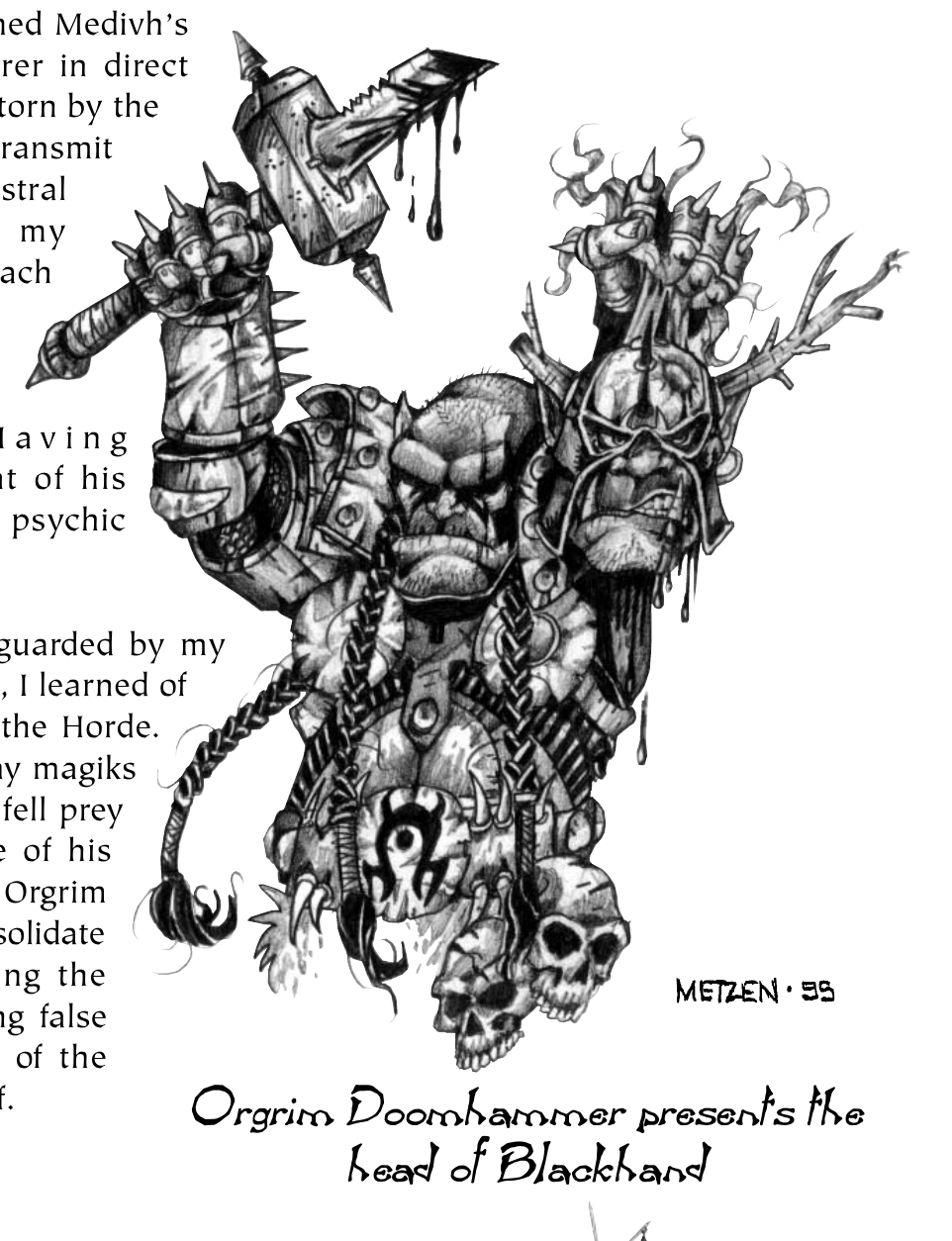
Here’s a question the Tides of Darkness manual doesn’t really answer: Why did Doomhammer invade the north in the first place?
No, seriously, why? What was he trying to accomplish? We don’t know his thought process, because the orc section of the Warcraft 2 manual is written from Gul’dan’s perspective, and it ends with Gul’dan pretending to submit to Doomhammer before the invasion even begins.
I’m not saying the manual should have answered this question. I’m not even sure the writers thought about it. From the perspective of the Warcraft 2 writers, the orcs were evil conquerors who invaded new lands simply because they were there. It certainly fits with the characterization of orcs given by Garona in the Warcraft 1 manual and by Gul’dan in the Warcraft 2 manual. So I’m willing to believe that Orgrim’s Horde saw new lands to conquer and rose to the challenge because it could. Orgrim himself lacks a character entry in the manual, so we don’t know his personal goals.
Indeed, this would only be a problem if Orgrim somehow became an important character for the larger Warcraft universe once again. If he once again gained agency after becoming a prisoner of war, or if his agency in the Second War was revealed in hindsight. Because if his goal was as simple as, say, giving the orcs a new home after Draenor was ruined, he could have simply conquered Stormwind and stopped there. The southern continent had plenty of verdant land to settle on, the humans left behind plenty of infrastructure, and while I’m not a warfare expert, I’d assume that waging a defensive war against the Alliance would be easier than an offensive one — especially with easy access to reinforcements through the Dark Portal.1
As it turns out, by waging an offensive war, Doomhammer simply overextended himself. He certainly thoroughly prepared for the Second War; by the time Tides of Darkness begins, the Horde has already captured all lands south of the Thandol Span and built up outposts, fleets, and factories. The Second War was a war between two coalitions of roughly equal strength; indeed, in the ending of the orc campaign, the Horde wins, bringing the entire continent under its heel. So far, Beyond the Dark Portal, a sequel to the ending where the Alliance won, is vague at where exactly Doomhammer’s Horde canonically faltered, only mentioning that Gul’dan’s renegade clans were slaughtered by their own kin.
I’ll say more on this matter once we get into later lore and more retcons regarding Orgrim and the Second War pile up. For now, remember the yet-unanswered question of his motivations.
The Horde Identity
The Horde of Warcraft 1 (which wasn’t even named that by the game) and the Horde of Warcraft 2 are two very different beasts.2
- The Monster Horde, led in Warcraft 1 by the Shadow Council and Blackhand3, is a swarm of demonic locusts, devouring everyone and everything in its path and poisoning the very land — which the Warcraft 1 manual implied was simply the way orcs were. With no technology except catapults, they favor brute strength and dark magic, making pacts with the infernal denizens of Hell4.
- The War Machine Horde, led in Tides of Darkness by Orgrim Doomhammer, is a coalition of races driven by their own interests, wielding dark magic and technology in equal measure. They are industrialized, building zeppelins, foundries and oil tankers just like the equally industrialized Alliance, and command disciplined armies in a war of methodic, relentless conquest led by a glorious strategist.
These two concepts are incompatible. The War Machine Horde isn’t doing the demons’ bidding — they’re not slaves, they’re conquerors, and they tolerate the dark arts only for as long as they advance the goal of conquest. Meanwhile, the Monster Horde sneers at such mundane concerns as tactics, supply lines, and good relations with their supposed allies. They exist only to raid and kill, and the only reason they haven’t yet destroyed themselves to infighting is that they have brilliant leaders to unite them, however briefly.
So we’re two games in and already we have ambiguity whenever someone says they’re a Horde fan. The immediate question I would ask would be “Which Horde?”
And this question will get only more nuanced as the franchise progresses.
New(ish) Mechanic: Hero Units
Beyond the Dark Portal makes heavy use of special units representing named lore characters. Though hero units are not strictly a new mechanic, as you controlled Cho’gall and Uther in Tides of Darkness, the expansion goes much farther with this idea. Each faction’s campaign has five heroes who appear throughout the story and get involved in the plot. Gameplay-wise they’re beefed-up versions of regular units with unique portraits and voice lines.
Though a neat idea in theory, in practice it can become a hindrance. Losing any hero unit instantly fails the mission. In missions where you command a limited army without a base, this is generally not a problem, as you’re micromanaging your units to keep them alive, but on base-building missions, whatever meager advantage hero units provide over regular units of their type are offset by the danger of accidentally losing them to the fray of battle with large armies clashing. This disincentivizes risking them and incentivizes simply keeping them at your base for their own safety.
We’ll see later how Warcraft 3 solved this conundrum.
The Draenor Horde Campaign
The orc campaign in Beyond the Dark Portal immediately starts with a retcon. This doesn’t bode well.
We’re once again shown the human victory cinematic with the Dark Portal being destroyed by a mage who is now clearly identified as Khadgar. Except now it turns out that while the physical portal was destroyed, the dimensional rift between the world still remained. Turns out Khadgar is a pretty shit wizard.
Wait… I thought the whole point of having a mage close the portal was undoing whatever Medivh and Gul’dan did to connect the worlds in the first place? If the rift stayed open, what was even the point of destroying the frame? Apparently the physical portal isn’t required to pass through in either direction, seeing how the entire Bleeding Hollow clan was able to escape to Draenor by playing “look, over there!” with the wizards of Nethergarde. So if, for all intents and purposes, the actual portal remained, what did Khadgar even do that couldn’t be accomplished by catapults and explosives?
Anyway. On to the campaign proper. It begins on…
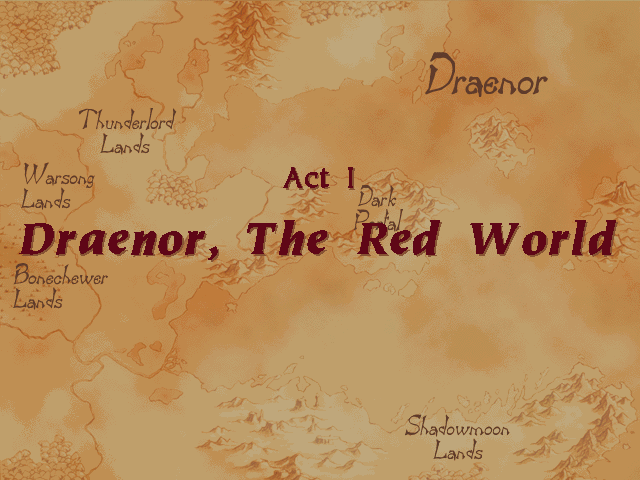
This act is devoted to civil war on Draenor, so you only fight orc enemies and no humans appear.
-
Elder Shaman Ner’zhul5, Warchief of Draenor, shares his plan with you, the Slayer of the Shadowmoon clan. He has discovered how the rift between Azeroth and Draenor was first formed, and wants to not only reopen it, but to open rifts to new worlds.
This is only the first mission, which introduces the premise of the entire campaign. Unfortunately, that premise is stupid.
The Horde has just lost half its clans and its most capable general unsuccessfully trying to conquer one world, so clearly the right course of action is to invade many worlds at once with whoever’s left! While also leaving the original Dark Portal open as a giant “go beat us up while we’re distracted” signal for the Alliance.
The most reasonable thing to do for Ner’zhul for now would be to cut his losses. With Gul’dan dead and the Horde no longer in service to warlocks and their daemon master Kil’jaeden, perhaps in time they could restore Draenor, which in this campaign is depicted as habitable, if only barely. Then maybe, once the Horde recovered its strength, it could pick one world to invade and hope it would be easier pickings than the one that just gave them a beating. And even that’s a long shot that would depend on how typical the human homeworld is.
Also, how did Ner’zhul suddenly learn how to open portals? The original Dark Portal was a collaboration between Medivh, guided by an unknown presence from the Twisting Nether, and Gul’dan, taught by the daemon Kil’jaeden. There’s no indication Ner’zhul, a shaman, was privy to their secrets.6
The mission proper involves no base building. The objective is to subjugate an order of death knights who somehow know how to rebuild the Dark Portal, and who are currently controlled by Mogor the Ogre of the Laughing Skull clan because… reasons?7 Oh, and while the mission briefing says to subjugate them, the gameplay objective is to destroy them. Sure, kill the people whom you’re trying to recruit for their vital knowledge. It makes perfect sense!
We start with a small force and have more units join us across the way, including Grom Hellscream and… troll axethrowers and goblin sappers?
That’s right, the Draenor clans use the exact same tech tree as Doomhammer’s Horde in the Second War, including shipyards, foundries, troll lumber mills, and goblin alchemists. While I can grant that the building blueprints and the engineering knowledge could have been shared across worlds, the presence of trolls and goblins really makes no sense, since neither race is native to Draenor. Furthermore, the aesthetics of the Second War Horde, with its War Machine identity, are unfitting for the Draenor clans, which retain the Monster Horde feel.

-
To restore the Dark Portal, Ner’zhul needs the Skull of Gul’dan, which is wielded by an orc captain of the Bonechewer clan, so that’s your next assignment.
Wait a minute. I thought Gul’dan died in the Tomb of Sargeras. How did his skull get to Draenor? The writer drops this bomb on us and doesn’t bother to elaborate.
Sure, Doomhammer’s warriors who destroyed Gul’dan’s clans could have brought his skull to Doomhammer, who then could have sent it to Draenor. Emphasis on could have. But we players shouldn’t have to do the writers’ work for them. When they ask us to suspend disbelief, it’s their job to smooth things over — in this case a single sentence in the manual about the fate of Gul’dan’s remains would have sufficed.
And that will be a recurring pattern with Warcraft writing later, as we’ll see. Weird, puzzling, but not totally implausible lore developments that could be fixed with a single sentence each if only anyone cared enough to do it.
Anyway, this is a straightforward mission. We start without a base with just Dentarg the ogre, but soon we get some troll axethrowers (ugh) and Korgath Bladefist [sic] from the Shattered Hand clan, a rudimentary base from the Thunderlord clan, and destroy the Bonechewer clan base across the river.
-
The Bonechewer clan disagrees with Ner’zhul’s plan to invade new worlds. Instead they want to go to Azeroth and succeed where Doomhammer has failed. Clearly the scheming Ner’zhul is going to replace their chieftain with one more agreeable to his plans… Just kidding, you’re actually tasked with exterminating them down to the last orc. You’re also tasked with exterminating the Thunderlord clan, who until now have been our allies, for the crime of also disagreeing with Ner’zhul’s plans. Instead of, you know, trying to reach some kind of compromise or trade of favors. Dissent with the Great Leader will not be tolerated and is punishable with genocide!
…How did these doofuses nearly conquer the Seven Kingdoms, again?
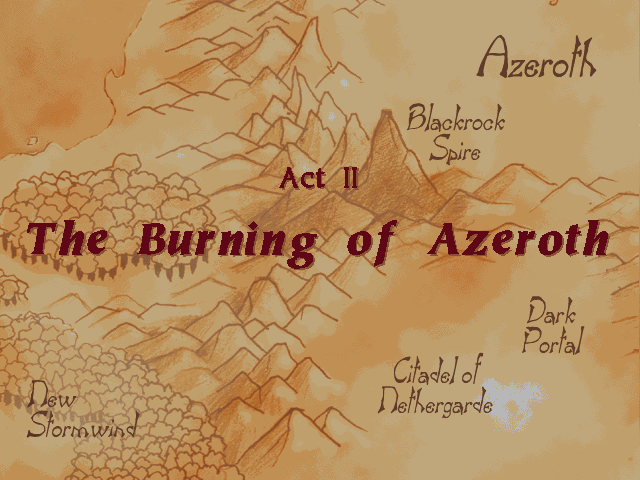
-
The death knight Teron Gorefiend has pledged the death knights of Draenor to Ner’zhul on the condition that they get a world they claim on their own. It seems Mogor has actually been up to something, as defeating him somehow gave Ner’zhul the knowledge needed to awaken the rift to Azeroth. You step through the Dark Portal once again and–
…Wait. We’re trying to open portals to new worlds. Why are we going back to Azeroth? What is our goal here?
Turns out we do have one, but for now, Ner’zhul hasn’t shared it with us, which is baffling. He sent his military commander to the world that had already given the Horde a beating, without elaborating what we’ll be doing here. Repeating Doomhammer’s war of conquest? Liberating the orcs in the internment camps? Trying to sail across the sea to the unknown west while leaving the humans in peace? Something else?
This is important knowledge that absolutely affects the Slayer’s plans. As it stands, we don’t know how long we’ll be staying here and whether we should be erecting fortresses and consolidating our power in this region, or simply camping somewhere out of the humans’ sight.
The actual mission gives us Teron as a unique death knight. The goal is, as usual, to destroy all enemies, in this case various human bases near the site of the Dark Portal. Once you start the mission, your lone zeppelin in the northwest is immediately attacked. That zeppelin is a clever way to direct your attention to the path you’re supposed to be following. The most natural path from your starting location would lead you to the well-fortified blue base in the center of the map, where your starting army would be promptly slaughtered before you can establish a base of your own. Instead, the zeppelin alerts you to the existence of the small, lightly defended green base in the northwest, which you can take out and then build a base of your own in its place.

-
Your next task is to get some dragons back in the Horde, which lost them after the Dragonmaw clan was captured by the Alliance and Alexstrasza was freed.
Again, it is only from a mission briefing that we learn about something substantial that happened between the two games offscreen. Ah well. This Alexstrasza gal is probably nobody important if her liberation wasn’t even worth spending a single manual sentence on, let alone a whole book or something.
So you attack Blackrock Spire, which once again has changed geography between games, and recruit the… green dragons?
…I should have probably mentioned this earlier. Dragon sprites in Warcraft 2 are green, with their allegiance represented by the color of their wings. In the Tides of Darkness campaign, you only have them for the last two missions, where you’re the red player, so they’re green with red wings. Here, for some reason, the capturable dragon units are assigned to the green player, so they’re fully green.
For now, there’s nothing to indicate that dragons come in any different colors except green. The multicolored wings I’ll chalk up to gameplay mechanics. We’ll see how this turns out.
And we still don’t know what our actual goal here is. We’re just recruiting allies for… an unknown task that may or may not require them later. But Ner’zhul has apparently read the script and knows that it will totally make sense in the end, making him this game’s version of the Illusive Man.
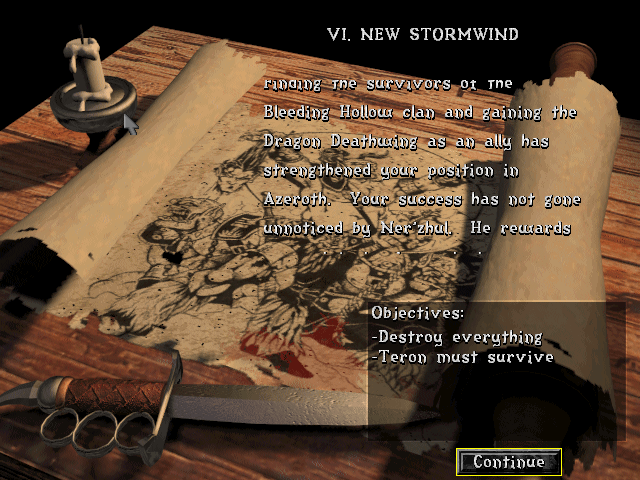
-
Unfortunately, this is where things turn outright stupid.
You’ve gained the allegiance of the dragon Deathwing (though the dragons you got in the previous mission were all unnamed). Gorefiend has sensed a focus of arcane energies from New Stormwind, which Ner’zhul concludes can only be the Book of Medivh, because ancestors forbid some other arcane artifact give off an equally strong arcane presence.
So how are you supposed to take the Book of Medivh? Perhaps send burglars to covertly steal it from Stormwind Keep? Maybe Garona, who already got there once to assassinate King Llane? Maybe hire some local thieves to do it for you?
No, it turns out. Since the only thing that interests you here is this one book, clearly the right answer is to raze New Stormwind to the ground. Never mind that it took the original Horde years of preparation to capture the original Stormwind, and they only did it on their second attempt under Orgrim’s command, and that was when Stormwind was on its own with no Alliance breathing down Orgrim’s neck. But now you just capture it on a whim when Ner’zhul suddenly learns they have something he wants, because nobody in this campaign needs preparations or battle plans.
The mission, to its credit, has a nice idea. You face two human bases, but the green one is behind rocks. Though they cannot attack you by land, they can and will send gryphon riders to your base while you’re busy fighting blue. You can take them out with dragons alone or to destroy blue first, then send goblin sappers to open a land route to the green base.
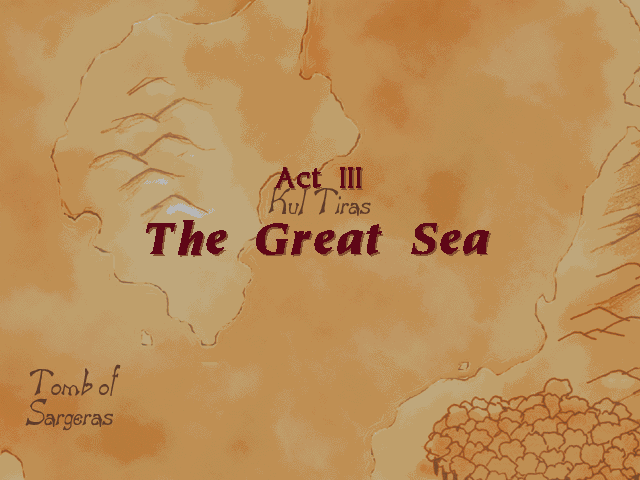
-
Sorry, Mario, but the Book of Medivh is in another castle! Specifically, you don’t find it in New Stormwind. But wait — I thought Teron sensed an arcane aura? Wouldn’t he similarly sense that the Book was no longer here? Dear writer, if you’re pulling out handwaves about how the protagonists know about the location of artifacts, at least keep their super-senses consistent.
Specifically, one of the footmen guarding the book was killed by an Alteraci dagger, which clearly means it was taken to Alterac, because there is no possible other place where an assassin wielding an Alteraci dagger could have taken it (such as, I don’t know, a black market for plot-relevant artifacts somewhere in Lordaeron or Quel’Thalas).
Given such a flimsy lead, your natural response is to reach Alterac by…
…sailing north?
On what ships? Orgrim spent years building up his fleet between the First and Second Wars, and the Alliance presumably destroyed or captured it all. You’re commanding a remnant of the Horde with a fraction of Orgrim’s power base. Where are you going to get your fleet? For that matter, why do you need a fleet? If you just care about stealing one magic book, surely that can be arranged without so much fuss that it will alert the entire Alliance?
Granted, the mission does involve you building five shipyards and obliterating the ships of Kul Tiras on this map, but the notion is laughable. Kul Tiras is the naval powerhouse of the Alliance. They had a centuries-long head start, plus they probably have retrofitted Doomhammer’s ships and shipyards. The timeline in this campaign is vague, but clearly you can’t afford to waste too much time before the Book of Medivh is moved to another unknown location, so how long is your ship-building spree actually taking place?
-
But all that pales in comparison with the stupidity of the next mission, which asks you to destroy Kul Tiras. Supposedly it won’t bring the wrath of the Alliance upon you because Daelin Proudmoore has left the Alliance, and there is absolutely no way the Alliance won’t reassemble the moment they receive news of orc ships entering the northern seas.
This mission’s premise defies belief. You’re not trying to conquer the human lands. That’s not why you’re here. You were pushing out of the Dark Portal and gathering allies for an unknown purpose that now, midway through the campaign, turned out to be stealing artifacts for Ner’zhul. The grand total of your business on the northern continent, right now, is one single magic book.
Your forces, as far as I can tell, consist of just the Shadowmoon, Shattered Hand and Warsong clans, the remnants of the Bleeding Hollow clan, Teron Gorefiend’s death knights, and Deathwing’s dragons. You have massacred two orc clans back on Draenor for daring to disobey you, one of them your former ally. You have no real forward bases in the human world, no entrenched power base, no dominion over the southern continent, and now you’re asked to destroy an island kingdom with the mightiest navy in the known world for the sake of retrieving a single magic book. I ask again: you and what army?
Imagine an alternate World War 2 where after Nazi Germany surrendered, for some reason the Allies didn’t immediately go after Japan. So a Japanese strategist hatches a daring plan to steal the plans for the Nazi nuclear program from an occupied Germany, so Japan can build nukes of its own. As an admiral of what’s left of the Imperial Japanese Navy by that point, you receive your mission briefing, which reads thus: “We need to break into German physics labs, but that pesky Britain is in the way. Sail across the world and burn London to the ground!”
I probably don’t need to point out the sheer degree of the absurdity of this situation.
-
Thankfully, we take a break from destroying random human kingdoms with an army and fleet we shouldn’t have. We raid the Tomb of Sargeras (which, of course, has completely changed its geography between games) to obtain the Jeweled Scepter of Sargeras, which Ner’zhul knows exists because he
read the scriptlearned it from his psychic link with Gul’dan that the writer just suddenly decided existed.8This is actually a nice breather mission without base building. You start with a small limited army. There is some sailing, some fighting, and it’s a mission that rewards exploration, as you can find reinforcements and upgrade buildings on side paths along the way. You fight skeletons (lorewise the remains of Gul’dan’s lackeys), Alliance troops, and a particularly strong daemon, who are hilariously all allied with each other, with the human paladins even healing the skeletons.
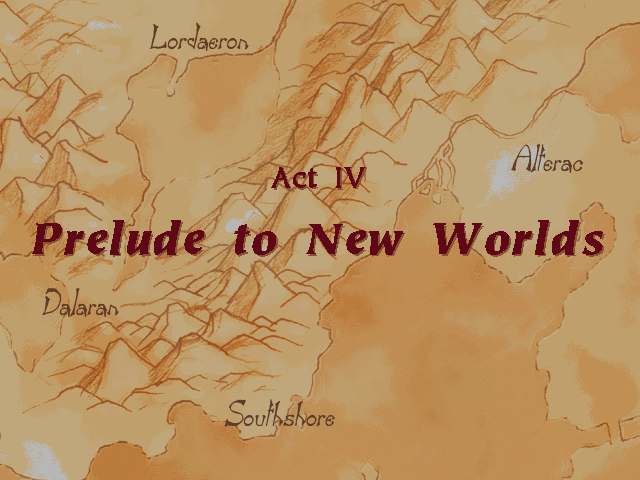
-
Never mind, we’re back to stupidity. Deathwing and his dragons have delivered you to the keep at Alterac, and the Alteraci have hidden the Book of Medivh from you. They fear the retribution of Lordaeron and Stromgarde if they reveal the location of the Book to you, so they propose a deal: they’ll give you the book if you wipe out foreign militaries near their borders.
This is a premise so mind-bogglingly stupid that I struggle to believe this game is a sequel to Tides of Darkness. It feels like the writer skimmed through the Tides of Darkness manual and then wrote a Mad Libs plot with the names of the human nations filled in.
First of all, how is Alterac still standing? The Alliance destroyed its capital in Tides of Darkness, and it’s reasonable to assume that it would be either annexed by neighboring kingdoms, or receive a new leader more loyal to the Alliance than Lord Perenolde was. The presence of the armies of Lordaeron and Stromgarde implies Alterac is under some kind of military occupation, but the narration here is too vague to make definite conclusions.
Second of all, why did the Alteraci steal the Book of Medivh from New Stormwind? Apparently they themselves didn’t use it in any way, and all it would do is further aggravate the Alliance if they found out.
Third of all, why would Lordaeron and Stromgarde punish Alterac for giving away the Book of Medivh to the orcs if they don’t even know it’s there? There’s no indication that anyone but you learned it’s in Alterac to begin with, and you only discovered it by accident. And if the Alliance learned the book was in Alterac, wouldn’t it punish those responsible for stealing it from Stormwind in the first place?
Fourth of all, you’re not staying in Alterac for good. Your goal here is just the book. If you destroy the Lordaeron and Stromgarde garrisons, what’s stopping them from simply moving in new ones after you leave? And if they didn’t know about the book theft before, they will definitely know now that orcs aided Alterac in destroying the border outposts, which will likely result in the Alliance seizing what’s left of the kingdom and leaving nothing to chance this time.
Fifth of all, where does your orcish army in this mission even come from?
According to the mission briefing, Deathwing carried you to Alterac by air, which I assume means you alone — unless you’re suggesting that the dragons somehow ferried all your orc warriors, and their catapults, and your death knights (and their horses!), and the supply carts, and your peons and blacksmiths and engineers and shipwrights and… and… and…
You get the point. In Tides of Darkness, whichever side you played, your victory felt earned. The orc campaign saw you chipping slowly into enemy territory, bit by bit, fighting for every patch of land, taking care to assemble your forces before decisive strikes. It paid attention to the importance of forward bases, supply lines, and patience. That’s what made victory over the Alliance, on their home turf, all the sweeter and established Orgrim Doomhammer as a competent strategist.
None of that happens here. Not only do you help Alterac accomplish something that will only hurt them in the long run, to solve a problem they shouldn’t have, creating even worse probems for them in the process, — but you also do it with an army that magically poofs out of nowhere. The only way this mission (and much of the entire campaign) makes sense is if the writer believes the world literally works according to the game mechanics: that constructing barracks and shipyards takes mere dozens of seconds and that grunts and dragons simply pop into existence.
It’s a shame the premise is so awful, because the mission itself is pretty nice. You start with a few Alteraci knights that you can’t replace. There are two bases to destroy and there is a small ship segment that involves recovering and escorting an Alteraci mage from an island, just for variety.
Ugh. We’re cleary not supposed to think about this too much. Don’t ask any questions, just kill red and blue and enjoy your orange human allies. Worldbuilding is for nerds.
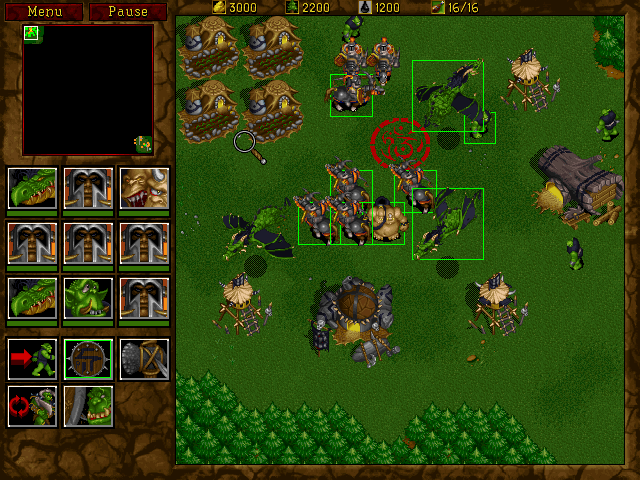
-
The next mission is not as stupid as the last one, but is pretty stupid nonetheless.
To complete his artifact collection, Ner’zhul wants the Eye of Dalaran, a focusing device constructed by the mages of Dalaran to rebuild the Violet Citadel.9 So you have to tear through Lordaeron’s defenses into the nation of Dalaran and destroy everything of violet color on the map.
Of course, it’s ridiculous that you’re just invading the northern continent on a whim without any kind of preparation, and that you’re just again burning an entire kingdom to the ground for a single artifact. But at least this mission sells the idea that you’re the underdog and kind of winging it by making you start on a small island surrounded by massive fortifications of the white player (Lordaeron) on your way to the violet player (Dalaran). Destroying white is technically not an objective here, but they’ll be a perpetual thorn in your side if you don’t at least cripple them.
The geography scaling in this mission is also ridiculous. Here is the entire map. It’s supposed to represent the entirety of southwestern Lordaeron. That small cross-shaped island in the northeastern corner? That’s the Violet Citadel of Dalaran, which in Tides of Darkness was an entire map on its own. Somehow we’ve got greater scale compression for what’s supposed to be a lower-stakes plot.
-
And now, the mission finale, which finally has a premise that makes sense: you have to retake the Dark Portal that has been besieged by human armies, so you can get back to Draenor. There’s even some geographical consistency with Tides of Darkness here, with the Portal placed on a small island surrounded by a circular island.
This is a “final exam” mission. You start without a base, just with some troops, peons, and all five of your heroes, against four human bases that greatly outnumber you. Your enemies are the kingdoms of Azeroth and Dalaran, which makes sense, and Lordaeron and Kul Tiras, which doesn’t. Wasn’t Kul Tiras supposed to have left the Alliance? Even more strangely, it’s Azeroth and Lordaeron that use navies here, while the Kul Tiras base is completely inland.
Sometimes it feels like this campaign’s designer simply assigned colors at random.
The Finale
Congratulations! You’ve massacred your own kin and allies on Draenor, lost a good deal of Horde forces frantically going north, south, and sideways on a wild romp across the human kingdoms, and implausibly destroyed two of these kingdoms as collateral damage on the way to your real plan, which was getting Ner’zhul four artifacts so you all can abandon everything you’ve conquered throughout this campaign and leave the human world for good.
Ner’zhul holds the ancient scepter of Sargeras in the air and intones the final words of the Spell of Conjuration. The air above you begins to swirl and presses down upon the assembled masses of the Horde. Above you, the crimson skies break open and reveal the chaotic pathways of the Twisting Nether.
As Ner’zhul deploys his remaining forces towards the new portals, you glimpse the Shattered Hand and Warsong clans awaiting orders on the other side of the Dark Portal.
“Master”, you ask. “Should we not recall all of our forces from Azeroth?” “No,” the ancient Shaman replys [sic] coldly. “They have served their purpose. From this point on, all that we gain will be ours alone.” Ner’zhul gives a wicked grin as you unquestioningly follow him into the swirling madness of the Twisting Nether.
If the story so far wasn’t baffling enough, this is the final nail in its coffin. Ner’zhul just leaves two clans loyal to him, which made his victory possible, on Azeroth because… he’d rather not share his future victories with them?
They are his war assets. Ner’zhul is about to start his far-fetched plan of waging war against multiple worlds at once after his predecessors failed to conquer even one. The Horde’s resources have dwindled, with Orgrim’s clans captured by humans (with Ner’zhul’s Horde making no attempt to free them), the Stormreaver and Twilight’s Hammer clans exterminated for treachery, and the Bonechewer and Thunderlord clans exterminated because Ner’zhul is a shortsighted “my way or the highway” dictator. He’s going to need every single able-bodied warrior he can get, and maybe focus on one world at once. And now he’s abandoning two whole clans that did him no wrong and that answer to him, simply because they answer to their chieftains rather than directly to him.
How did these doofuses nearly conquer the Seven Kingdoms, again?
Intermission Thoughts
The Mission Design
I actually like the mission design of this campaign far more than of either Tides of Darkness campaign. They’ve pushed the admittedly limited engine to its fullest extent and tried to make the missions as diverse as possible, from simple adventures to truly epic battles. Furthermore, they realized that not every mission has to feature naval combat, and in most missions, ships are either entirely absent or are featured only in a limited role to give flavor. It seems the mission designers learned the lessons of both Tides of Darkness campaigns, and this is simply the best that Warcraft 2 gameplay has ever been.
As a small note, I’m confused about color choices in places. Throughout this campaign, you mostly fight the kingdoms of Azeroth (blue), Dalaran (violet), and Kul Tiras (green). The placement of the first two mostly makes sense, but Kul Tiras ends up popping up in places where it has no business being, such as in the lands of New Stormwind or around Blackrock Spire. In the first mission on Azeroth, the big base that’s apparently supposed to be Nethergarde Keep is colored Azeroth’s blue, while Dalaran only has a tiny outpost in a corner. And then there’s the coloring error in the very first mission, where you’re supposed to be fighting the Laughing Skull clan, but the enemy is instead colored as the Shattered Hand clan, your lorewise allies.
I wonder how much of that is a trace of earlier story drafts, and how much is pure sloppiness.
The Story
What happened?
Seriously, what happened?
How is Tides of Darkness so relatively thought out, if generic, while this campaign involves such massive leaps of logic, implausible armies appearing out of nowhere, and characters not acting according to their stated goals?
I don’t know who actually wrote the Beyond the Dark Portal campaigns. The credits attribute “campaign design” to Cyberlore Studios, with Blizzard’s Chris Metzen and Bill Roper only listed as storyline consultants. And sure, you could attribute the narrative faults of this campaign to different writers who didn’t know the setting so well. You could attribute it to the ill-fitting game assets, to having to tell a story about the Monster Horde with units and buildings designed for the War Machine Horde. You could attribute it to Blizzard having no real plan on how to continue the Tides of Darkness story, and winging the expansion lore.
But I think the fundamental issue is the disconnect between the game’s genre and the story’s intended genre, the kind of story the writers wanted to tell. This campaign is a heist story about four evil adventurers (and a dragon) stealing artifacts, but the highly limited scripting capabilities of the Warcraft 2 engine meant the actual missions still had to feature gameplay designed around clashing armies and fortress sieges. It’s an adventure story wearing the fake moustache of a warfare story, one that would be more appropriate for Warcraft 3 or World of Warcraft than the game it was actually featured in.
It’s no surprise, then, that in later lore, the heist aspects of this storyline were left in while the accompanying warfare and destruction were pretty much retconned out of existence.
In two posts from now, I’ll speak in more detail about the conflicting needs of warfare and adventure stories. For now, let’s move on to the other side, the human campaign, and hope it will be better.
Next time: the explosive end to Warcraft 2!
-
Chronicle volume 2 presents a justification I personally find unconvincing, but it’s far too early to talk about it. Let’s just say that “we’re invading them before they can invade us”, used as in-character justification, will implode in a complete narrative mess going way, way forward. ↩
-
I took the particular terms “Monster Horde” and “War Machine Horde” from the blog Ramses Reviews, which I highly recommend and will return to many times later. ↩
-
And by Gul’dan from the shadows — retroactively, as he was only introduced in Warcraft 2. ↩
-
Hell, Hades, the underworld, as Warcraft 1 interchangeably calls it. The name “Twisting Nether” is a Warcraft 2 invention. ↩
-
The Tides of Darkness manual previously described him as Gul’dan’s teacher. ↩
-
You could say Ner’zhul got that knowledge from the Book of Medivh, but obtaining it only becomes his explicit goal at the end of Act 2, so his plan makes no sense unless he has read the script ahead and knows that obtaining the Book of Medivh will even be an option. Also, admittedly, one mission briefing says — later — that Ner’zhul learned of Gul’dan’s studies through a psychic link between them, but we don’t know that yet. ↩
-
The mission briefing says he needs them for some kind of necromantic ritual, but it’s never elaborated upon. ↩
-
While you’re at it, are you sure there aren’t any other artifacts in the tomb you’d like to grab besides just the Scepter, Ner’zhul? Maybe some kind of eye? Though of all the gaffes that this campaign’s writer made, not featuring an artifact that hasn’t been invented yet isn’t one of them. ↩
-
It’s not made terribly clear if the Violet Citadel is in the city of Dalaran, or if it is the capital city of the nation of Dalaran, or if it’s a separate location entirely. Also, since the Horde doesn’t get anywhere near the Violet Citadel in the human campaign of Tides of Darkness, it’s fair to assume that the penultimate mission of the orc campaign, where you attack Dalaran, is part of the Beyond the Dark Portal continuity. ↩
Leave a Comment